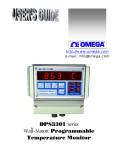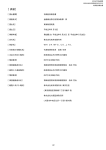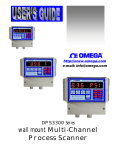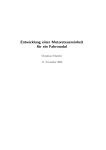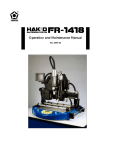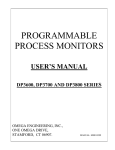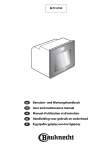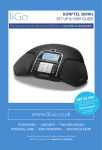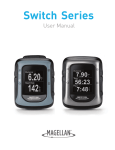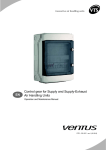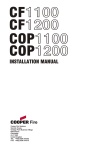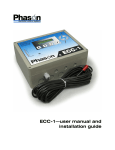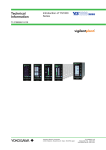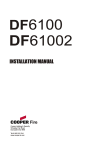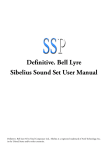Download Manuals - OMEGA Engineering
Transcript
User’s Guide Shop online at omega.com SM e-mail: [email protected] For latest product manuals: www.omegamanual.info CN1511 SERIES Wall Mounted PID and On/Off Controller omega.com [email protected] Servicing North America: U.S.A.: Omega Engineering, Inc., One Omega Drive, P.O. Box 4047 Stamford, CT 06907-0047 USA Toll-Free: 1-800-826-6342 (USA & Canada only) Customer Service: 1-800-622-2378 (USA & Canada only) Engineering Service: 1-800-872-9436 (USA & Canada only) Tel: (203) 359-1660 Fax: (203) 359-7700 e-mail: [email protected] For Other Locations Visit omega.com/worldwide The information contained in this document is believed to be correct, but OMEGA accepts no liability for any errors it contains, and reserves the right to alter specifications without notice. SPECIFICATIONS .......................................................................................................................................................... 4 DESCRIPTION ................................................................................................................................................................ 5 THERMOCOUPLE OR RTD SELECTION................................................................................................................. 5 HOW TO RESET AND PROGRAM THERMOCOUPLE TYPE (OR RTD) .................................................................................. 5 FIGURE 1. THERMOCOUPLE/RTD SELECTION KEYS ..................................................................................................... 6 DISPLAY MODES........................................................................................................................................................... 6 RETAINING USER SETTINGS ON POWER DOWN................................................................................................ 6 FLOW CHART ................................................................................................................................................................ 7 'RAMP & SOAK PROFILE' SELECTION .................................................................................................................. 8 SETUP MODE................................................................................................................................................................. 8 ENTERING AND EXITING SETUP MODE: .......................................................................................................................... 8 HOW TO INCREASE/DECREASE PROGRAMMABLE VALUES IN SETUP .............................................................................. 8 PASSCODE ENTRY: .......................................................................................................................................................... 8 'PROGRAM CONTROLLER' MODE .......................................................................................................................... 9 SELECTING ON/OFF OR PID CONTROL .......................................................................................................................... 9 ENTERING ON/OFF VARIABLE ....................................................................................................................................... 9 On/Off Hysteresis (Dead-Band) ................................................................................................................................. 9 ENTERING PID VARIABLES ............................................................................................................................................. 9 Proportional band ...................................................................................................................................................... 9 Reset ......................................................................................................................................................................... 10 Rate........................................................................................................................................................................... 10 ENGINEERING UNITS (C/F) ........................................................................................................................................... 10 DISPLAY TIME ............................................................................................................................................................... 10 DISPLAY OPTION:.......................................................................................................................................................... 10 HEAT/COOL SETUP: ................................................................................................................................................... 11 RATE TIME-BASE:......................................................................................................................................................... 11 COLD JUNCTION ADJUSTMENT: ..................................................................................................................................... 11 THERMOCOUPLE CALIBRATION:.................................................................................................................................... 11 THERMOCOUPLE TYPE SELECTION: ............................................................................................................................... 12 ‘PROGRAM LIMITS’ MODE: .................................................................................................................................... 12 PROCESS LIMITS (1 THRU 4): ......................................................................................................................................... 12 SELECTION OF LIMIT 3 AS PROCESS OR RATE LIMIT:..................................................................................................... 13 PROGRAMMING LIMIT 3: ............................................................................................................................................... 13 As Process Limit:...................................................................................................................................................... 13 As Rate Limit: ........................................................................................................................................................... 13 SELECTION OF LIMIT 4 AS PROCESS OR DEVIATION LIMIT: ........................................................................................... 13 PROGRAMMING LIMIT 4: ............................................................................................................................................... 13 As Process Limit:...................................................................................................................................................... 13 As Deviation Limit:................................................................................................................................................... 13 CONFIGURE TIMING MODE............................................................................................................................................ 14 TIMERS 1 AND 2: ........................................................................................................................................................... 14 RELAY DEADBAND: ...................................................................................................................................................... 14 CONFIGURING LIMITS NORMALLY OPEN/NORMALLY CLOSED: .................................................................................... 14 RELAY LATCHING/NON LATCHING:............................................................................................................................... 14 AUDIO ALARM ON/OFF:................................................................................................................................................ 15 'VERIFY' MODE:.......................................................................................................................................................... 15 PROFILE MODE (ENTERING RAMP & SOAK): ................................................................................................... 15 Page 2 RAMP/SOAK PROFILE EXAMPLE .......................................................................................................................... 16 EXTERNAL CONTROL RELAY INSTALLATION FOR RAMP/SOAK OPERATION..................................... 17 Figure 3. Solid State relay hookup for controller output......................................................................................... 17 VARIOUS CONTROLLER MODES........................................................................................................................... 17 CONTROLLER RUN MODE ............................................................................................................................................. 17 CONTROLLER HOLD MODE .......................................................................................................................................... 17 CONTROLLER STOP MODE ............................................................................................................................................ 18 CONTROLLER MANUAL MODE .................................................................................................................................... 18 RATE............................................................................................................................................................................... 18 RATE ALARM: ............................................................................................................................................................... 18 RESETTING RATE ALARM: ............................................................................................................................................ 18 SETPOINT DEVIATION: ............................................................................................................................................ 19 DEVIATION ALARM:...................................................................................................................................................... 19 RESETTING DEVIATION ALARM: ................................................................................................................................... 19 PROCESS ALARMS ..................................................................................................................................................... 19 DISPLAYING: ................................................................................................................................................................. 19 RESETTING: ................................................................................................................................................................... 19 ELECTRO-MECHANICAL RELAY OPTION ....................................................................................................................... 20 Figure 4. Electro-mechanical Relays Hookup Example........................................................................................... 20 OPEN COLLECTOR OPTION ............................................................................................................................................ 20 Figure 5. Open Collector Hookup Example ............................................................................................................ 20 TIMERS .......................................................................................................................................................................... 20 RESETTING TIMERS: ...................................................................................................................................................... 21 TIMER MODES............................................................................................................................................................. 21 TIMER MODE #0............................................................................................................................................................ 21 TIMER MODE #1............................................................................................................................................................ 21 TIMER MODE #2............................................................................................................................................................ 21 ELAPSED TIME........................................................................................................................................................... 21 HOW TO RESET ELAPSED TIME ...................................................................................................................................... 21 HIGH AND LOW PEAKS ............................................................................................................................................ 21 HOW TO RESET HIGH & LOW PEAK READINGS.............................................................................................................. 22 OUTPUT STATUS:........................................................................................................................................................ 22 POWER........................................................................................................................................................................... 22 SIGNAL CONNECTION .............................................................................................................................................. 22 OUTPUT CONNECTOR PIN ASSIGNMENT .......................................................................................................... 22 TABLE 1. OUTPUT CONNECTOR PIN ASSIGNMENT ...................................................................................................... 23 FIG 6. CN1511 SERIES TERMINAL COMPARTMENT........................................................................................ 24 DIRECT INTERFACE TO UNIVERSAL RELAY MODULE ................................................................................. 24 DIRECT INTERFACE TO UNIVERSAL RELAY MODULE ................................................................................. 25 MOUNTING ................................................................................................................................................................... 26 Page 3 SPECIFICATIONS Typical @ 25 C and rated supply voltage unless otherwise specified. INPUTS: • • • Input types: J,K,T,E,R,S,B t/c, RTD, Voltage, Millivolt, Current & thermistor Cold junction compensation error: +/- 0.5C max (10C to 40C) Open thermocouple indication: ‘OPEN TC’ displayed OPTIONS: • • • • 240Vac @ 50 Hz Power Supply 15Vdc @ 1000ma. Power Supply Open Collector output: 6 open collector transistors @ 50ma. sink each Relay output: 4 SPST 1 Amp. @ 28Vdc, 0.5 Amp. @ 120Vac (resistive load) (for 220 Vac units only 0.25Amp.@ 240Vac (resistive load)) 2 open collector transistors @ 50ma. sink each ACCURACY: • • Temperature resolution: 1 C/1 F, 0.1C for Thermistor 0.1% of Full Scale (Base metal T/C), 0.5% others ANALOG TO DIGITAL CONVERSION: • 4 1/2 Digit (20000 count) A/D conversion. • Dual slope integrating converter. • Conversion Rate: 7 /sec. typical POWER REQUIREMENTS: • 120Vac, 0.2 Amp. @ 60 Hz DIMENSIONS: • Case: 7.55"W x 6.29"H x 4.05"D • IP65 rated plastic enclosure • Weight: 2.63 lb. (1.19kg.) • Enclosure: All Plastic enclosure—IP65 Ingress Protection DISPLAY: • Red 7-segment LED display, 0.39 inch (10mm) digit height • Negative polarity indication • Out of range indication: HELP • Display Test: Briefly displays 8.8.8.8.8.8.8. on power up RELIABILITY: • Calibration: NIST traceable • Recalibration: Recommended at 12 months interval Page 4 DESCRIPTION The CN1511 series is a highly versatile temperature controller which offers the ease of an ON/OFF controller combined with the precision of a PID controller. Selectable heat/cool mode allows the unit to be used for either heating (direct acting) or cooling (reverse acting). The unit has the capability of accepting five different ramp and soak programs, each one with up to ten segments. Separate pass-codes are required for selecting or entering a program. This keeps the operators from making any inadvertent changes. Manual hold feature allows for an indefinite hold any where along the ramp/soak profile. Also offered is a manual set-point entry mode for a quick 'ramp to set-point' function. This eliminates entering a complete ramp/soak program. Maximum and minimum temperature readings are constantly tracked and can be helpful in quality control or monitoring unattended processes (e.g. overnight). Various process parameters monitored by the system may be displayed by pushing the appropriate keys on the front panel, e.g. (Rate, Peak etc.). The respective parameter will be displayed as long as the key is kept pressed. Alternately, if the key is pressed and then released, the unit will display a particular parameter briefly and then go back to temperature display mode. The CN1511 Series supports six outputs: 4 relay outputs for process limits and 2 relay outputs for timers. Process limit relays may be operated in two different modes: 1. Non-latching mode, in which the relays reset automatically as soon as the temperature falls below the limit (minus the relay dead-band). 2. Latching mode, in which the relays stay energized even after the temperature falls below the programmed limit. In this mode the relays will stay on until manually reset. THERMOCOUPLE OR RTD SELECTION CN1511 instruments ordered for Thermocouples or RTD’s can be programmed through the front panel keys to work with one of these specific inputs (Input type or options depends on Model number ordered). When CN1511 is first turned on, a ‘display segment test’ is done by briefly displaying 8.8.8.8.8.8.8., followed by the software revision number (rEn X.XX) and input signal type. Input type Display shows: J (R,S,B, rtd 385, Thermistor, J tC (r, S, B, rtd 385, Millivolt, Voltage, Current) K (rtd 392) T E Lo VoLt, HI VoLt, CurrEnt) Cr.AL tC (rtd 392) t tC E tC tHrStor, Factory default thermocouple/RTD selection can be obtained as explained below: How to Reset and Program Thermocouple Type (or RTD) A CN1511-TC that is calibrated for a J, K, T, or E type thermocouple or an RTD model may be programmed for a specific thermocouple, or RTD (385/392) type, by going into SETUP mode (Look under ‘SETUP’). Alternately, a thermocouple/RTD may be selected by turning On power to the unit while holding in the appropriate key (see Figure 1). This procedure also clears the memory and programs factory defalult values for limits, rate timebase etc. Therefore, after performing Power-up reset, various parameters such as Page 5 limits, ramp and soak profiles, rate time base etc., must be re-programmed. However, if done in SETUP mode, no programmed parameters such as limits, ramp & soak profiles etc. are erased from the memory. It is recommended that thermocouple (RTD) selection be done in SETUP. Power-up reset should be performed if it is suspected that program memory may have been corrupted due to power surge, noise on electrical lines etc. FIGURE 1. Thermocouple/RTD Selection Keys KEY Input Type Selected DATA K t/c, RTD392, Thermistor E t/c Memory Clear only J (R, S or B , RTD 385) Thermistor STOP K (RTD 392) RUN T TIMER E RESET Memory cleared – no factory default values . programmed. NOTE: All keys, except RESET, clear memory and program necessary factory default values. RESET key clears memory only and programs no default values. However, previous thermocouple type is retained. T t/c J (R, S or B) t/c, RTD385 DISPLAY MODES The CN1511 can be programmed to display in one of the following three modes: Mode Display Description PROCESS PrOCESS Displays only the process value. SETPOINT SEtPt Displays only the setpoint value. PROCESS - SETPOINT Pr-StPt Alternately displays Process as well as Setpoint value. SEE SETUP ON HOW TO SELECT ONE OF THE DISPLAY MODES. RETAINING USER SETTINGS ON POWER DOWN CN1511 saves all the programmed parameters in an EEPROM (electrically erasable programmable read only memory). An EEPROM stores the programmed parameters even when the power is removed from the unit. However, it is important to note that if the parameters are being changed during setup, they must be saved in the EEPROM by pressing and holding the ‘RESET’ key (till SAVING is displayed) as described under SETUP. If parameters are NOT saved and the power is removed from the unit, any newly changed values will be lost ( the unit will, however, maintain the old values). Page 6 FLOW CHART SETUP PROGRAM LIMITS PROGRAM CONTROLLER PROGRAM LIMIT1 Type of Control --PID or ON/OFF PROGRAM LIMIT2 Configure Limit3 as Process or Rate PROGRAM LIMIT3 Configure Limit4 as Process or Deviation PROGRAM LIMIT4 Select Timer Modes 0,1 or 2 VERIFY PROFILE SELECT PROG NO. PROG1, PROG2, ETC. SELECT PROG NO. PROG 1, PROG2, ETC If ON/OFF, Enter Controller Deadband START SETPT START SETPT If PID Mode, Enter Proportional Band ENTER SETPT1 ENTER SETPT1 ENTER TIME ENTER TIME ENTER SETPT2 ENTER SETPT2 If PID Mode, Enter RESET If PID Mode, Enter RATE DEGREE ‘C’ OR ‘F’ Verify segment 2 thru 9 Program segment 2 thru 9 ENTER SETPT10 ENTER SETPT10 ENTER TIME ENTER TIME Back to SETUP Back to SETUP PROGRAM TIMER1 DISPLAY TIME PROGRAM TIMER2 DISPLAY OPTION RELAY DEADBAND HEAT/COOL Limit1 Normally open or closed Limit2 Normally open or closed Limit3 Normally open or closed Limit4 Normally open or closed Limits Latching or Non-Latching Audio Alarm ON or OFF RATE TIMEBASE COLD JUNCTION CALIBRATION INPUT CALIBRATION INPUT SIGNAL TYPE Back to SETUP Page 7 'RAMP & SOAK PROFILE' SELECTION CN1511 has the capability of five different ramp and soak profiles. Each of these programs can have up to ten segments. The desired profile can be selected by going into SETUP mode and entering the correct pass-code. To enter setup, push and hold SETUP key till the display starts scrolling the message 'EnTER PASCOdE'. At this point two different pass-code options are available. One is to get into ramp/soak or system programming and the other is selection of an already programmed ramp & soak profile. To get into selection mode, enter pass-code '4523' (also look under SETUP). On accepting the pass-code, the unit will scroll the message 'SELECt PROG nO.' followed by the indication of active program number. The display format for program number is 'ProG x' (where x = the program number, which can be from 1 to 5). To select an alternate program, push ‘^ENTv’ key. After making the selection, push RESET key to indicate so. Doing so will also exit program selection mode. SETUP MODE Setup is used for configuring various parameters of CN1511 unit. These parameters include entering ramp/soak profiles, verifying temperature profiles, entering limits, timers, dead-bands etc. Entering and Exiting Setup Mode: To get into setup mode, press and hold SETUP key. The display will show ELPSd t and then the value of elapsed time. Keep holding-in ‘SETUP’ key till the display shows ‘SETUP’ and scrolling the message 'EntEr PASSCOdE'. To return from SETUP to normal display/run mode, simply push and hold down the ‘RESET’ key. On exiting, the display will briefly show 'SAVING' to indicate that the new data is being saved in nonvolatile memory (key should be held in until the word ‘SAVING’ shows up on the display). Setup mode is also exited automatically if no key action is detected for about 5 minutes. How To Increase/Decrease Programmable Values in Setup Once a parameter is displayed (e.g. 01234), the ‘^Ent v’ key can then be used for increasing or decreasing the value of the flashing digit. For incrementing, push and hold in ‘^Ent v’ key. To decrement, release ‘^Ent v’ key and immediately push it (and hold in) again. To move on to the next digit, push ‘<DIG>’ key till the desired digit starts flashing. Again, use ‘^Ent v’ key to change its value. Passcode Entry: Passcode entry is a four digit number which keeps unauthorized personnel from changing the unit’s parameters. Front panel keys are each marked with a small digit in the lower right corner. For the five keys there are five digits --- 1,2,3,4,5. Pass-code is a combination of these digits and for CN1511 units, passcode for selection of ramp/soak programs is 4523. The pass-code to program new ramp/soak profiles, limits , controller parameters Page 8 , etc. is 3254. Three attempts at entering the correct pass-code are allowed. Anytime a wrong digit is entered, the display will read HELP. If correct pass-code is not entered within three attempts, the system will exit SETUP and return to normal display mode. To make another attempt, you have to get into setup again by holding in ‘SETUP’ key. As soon as correct four digit pass-code is entered, the unit is ready for setup. At this point the unit will display ‘PrG Ctr’ (for 'Program Controller'). All the options available for programming at this point are: 1. PrG Ctr (for 'Program Controller’) 2. PrOG Lt (for 'Program Limits') 3. VErIFy (for 'Program Verification') 4. PrOFILE (for 'Ramp/Soak Profile') ‘PROGRAM CONTROLLER’ MODE The unit starts with 'Program Controller’ as the active mode (displaying PrG Ctr). To select any other mode, push ‘^Ent v’ key. Once the desired mode is displayed, push ‘SETUP’ key to select it. 'PROGRAM CONTROLLER' MODE Selecting ON/OFF or PID Control On entering Program Controller mode, the very first step lets you program the type of control i.e. simple ON/OFF or PID. The display will read ‘Pid Ctr’ (for PID control) or ‘On-OFF’ (for ON/OFF control). Push ^ENTv key to make alternate selection. Push SETUP key to go to the next step. NOTE: The next step depends on whether PID or ON/OFF control was selected. If PID mode is selected, then the next three steps programmed are Proportional band, Reset and Rate. For ON/OFF mode, controller deadband is programmed. Entering ON/OFF Variable On/Off Hysteresis (Dead-Band) Controller dead-band (hyteresis) determines how tight a control around setpoint is achieved. A smaller number results in a tighter control. This function is indicated by the message ‘CntL db’ followed by the value of previously programmed dead-band. The flashing digit is the active digit. Pushing ^ENTv key and keeping it pushed, will increment the digit. Releasing ^ENTv key and then pushing it again will decrement the value (^ENTv key works as a toggle -- alternating between increment and decrement). To change the next digit, first push the <DIG> key. This will advance the flashing to the following digit. Use ^ENTv key to change the value. After the desired setting is displayed, push SETUP key. This will take you to the next step. NOTE: This step comes up for programming only if the unit is programmed to work as ON/OFF controller. If not, Rate, Reset and Proportional Band are programmed. Entering PID Variables Proportional band If PID mode is selected, then next parameter to be programmed is the proportional band. Proportional band, also referred to as gain, determines the output in proportion to the error between setpoint and actual process Page 9 temperature. It is based on percent error of 1000 degrees if the display units are Centigrade and 2000 degrees if units are Fahrenheit (or scaled for voltage/current inputs). For example, if the proportional band is set to 5.0 and the units are Centigrade, then a process error of 50 degrees between setpoint and temperature will result in an output that will be fully on.To enter a new value for proportional band, use ^ENTv and <DIG> keys . Once the value has been entered, push SETUP key. Reset Parameter programmed after proportional band is Reset. As with other functions, this is indicated by the display first showing the message followed by current reset value. The message in this case is 'RESET'. Again, use ^ENTv key in conjunction with <DIG> key to change the value. Reset is used with proportional band to fine tune the controller. Proportional band alone will bring down the error between setpoint and process up to a certain point only. To reset the differential left by proportional band, the error is integrated slowly over time until setpoint and process coincide. This is done by introducing the reset factor. After programming reset, push SETUP key to program RATE. Rate Rate is the third factor in the PID control. This factor provides the anticipation for the control as to how fast or slow process change is being realized. This factor is usually handy at start ups when, generally, process tends to lag setpoint and a higher output is required. On entering rate mode, the display first reads 'RAtE' followed by rate value. This value can be change by using ^ENTv and <DIG> keys. Engineering Units (C/F) Following ON/OFF or PID parameters the next function that comes up for programming is the engineering units. The display will either show dEGrE C (for degrees Centigrade), or dEGrE F (for degrees Fahrenheit). Push ‘SETUP’ key once to maintain the present setting and to go on to the next function or push ‘^ENTv’ key to switch to alternate units. Display Time After setting controller dead-band, the next parameter is display time. This determines the length of time (in seconds) that the process or setpoint value is displayed before SETPT or PROCESS message is flashed. The unit will first show 'dSPLy t' (for Display Time), and then the current setting in seconds. Use ‘^ENTv’ and ‘<DIG>’ key to set the desired display time. Push ‘SETUP’ key following the selection. Display Option: This is indicated by the display briefly reading 'dSP OPt' (for display option) and then the currently selected Option. Three display options are offered: Process only, Set Point only or both process and setpoint. Use ‘^ENTv’ key to step thru these options. Once the desired option has been selected, push ‘SETUP’ key to enter it and go on to set Display Time. OPTION DISPLAY PROCESS SET POINT PROCESS-SETPOINT PrOCESS SEtPt Pr -StPt Page 10 DESCRIPTION Displays Process value only. Displays Setpoint value only. Displays Set Point & Process value NOTE: If PROCESS-SETPOINT option is selected, then setpoint is displayed only if the unit is in run or hold mode. If in 'STOP' mode, only the process value is displayed. HEAT/COOL Setup: Depending on whether the process control is required for heating or cooling, appropriate HEAT/COOL mode is selected in this step. The unit will display current mode as 'HEAT' or 'COOL'. To select alternate mode, push ENT key. After making a selection, push SETUP key. Rate Time-Base: This step is for programming time-base for calculation of Rate. Units of time-base are seconds. Again, the active digit will be flashing. Message displayed before the value is “rATE tb:. To change the value, push ^v key. To activate another digit for change, use <DIG> key. On finishing, push SETUP key. Cold Junction adjustment: After setting Heat/Cool mode, the next parameter is the cold junction reference temperature adjustment. The display will first show 'COLd JN' , and then the cold junction temperature will be indicated. Use ‘^ENTv’ key to adjust until the display reads the proper temperature. Once the correct temperature is displayed, push ‘SETUP’ key to enter that setting and go to temperature Calibration mode. NOTE 1: The unit comes pre-calibrated from the factory. However, the above procedure can be used if any adjustment is required to the Coldjunction reading. NOTE 2: Cold-junction temperture is the temperature of the connector that connects the thermocouple to the unit. This temperature is usually higher than ambient temperature, particularly after the unit has been powered for some time. This is due to the heat generated by internal electronics of the unit. For precise calibration, measure the temperature at thermocouple connector and then adjust Cold-junction reading. NOTE 3: No cold-junction calibration is required for RTD or thermistor units. Therefore, this step is omitted in RTD or Thermistor units. Thermocouple Calibration: For base-metal thermocouples (type J, K, T and E), calibrating one type of thermocouple calibrates all. While calibration can also be performed outside of setup procedure (in main Process display mode), doing this in ‘SETUP’ eliminates flashing ‘PROCESS’ message from interupting the procedure. Also, raw A/D input can be viewed in this mode by pushing ‘SETPT’ key. This allows for adjusting any offset errors and thus allows for more precise calibration. Thermocouple Calibration Procedure Note: Make sure the unit is reading correct cold-junction temperature before calibrating. If incorrect, adjust as described in the " Cold Junction adjustment" section. Page 11 For thermocouple calibration (type J T/C), following steps should be performed. Note that only one type of thermocouple need to be calibrated (i.e. J,K,T or E). For example, if the calibration is done for a type K thermocouple, types J, T, and E are automatically calibrated. 1. Connect a thermocouple calibration source to the signal input connector. 2. Dial in 725 degrees centigrade (Note: unit must be programmed for displaying in centigrade). 3. Adjust gain pot on the back of the instrument (ref. Fig. 7, Pg. 21) until the display reads '725'. 4. Short the input connector with a wire or shorting bar (make sure the source is removed so 5. 6. 7. 8. 9. as not to damage it --- shorting the input connector will short the output of the source). Push ‘SETPT’ key. The display will read 'U 00002' --- or some other value. Adjust offset pot on back of instrument (ref. Fig. 7, Pg. 21) until the display reads '0000'. Push SETUP key once -- the display should read close to Cold Junction temperature. Remove the shorting bar from the input and connect the thermocouple calibrator again. Repeat steps 2 through 7 till the unit reads proper temperature. NOTE 1: The unit must be powered up for at least ten minutes before any adjustments are made. NOTE 2: For calibrating units with RTD or Thermistor inputs, connect the source to input connector, dial in a temperature near high end of the scale and adjust gain potentiometer on the back of the unit (See figure 7 for reference). Thermocouple type Selection: Next function is the last one in system setup. Here you select the type of thermocouple for which the unit has been calibrated. First the display shows the message ‘IP tYPE’ (for ‘Input Type’) followed by current thermocouple selection. For various thermocouples the unit reads: Thermocouple type J K T E Display shows T/C T/C T/C T/C J tC Cr.AL tC t tC E tC For units with RTD input, the selection is between RTD 392 or RTD 385. Thermistor units display ‘tHrStOR’ (for ‘Thermistor’) and units with R, S and B type thermocouples display ‘r tC’, ‘S tC’ and ‘b tC’ respectively with no selection option (since these units offer only one type of input) To make an alternate selection, push ‘^ENTv’ key. After making the selection, push ‘SETUP’ key. This last push will take you to the very beginning of setup mode with the display reading 'PrG Ctr’. At this point either push RESET key to get out of setup or select any other option as described before. ‘PROGRAM LIMITS’ MODE: Process Limits (1 thru 4): If selection made from programming groups is for ‘PROG LT’ then the very first parameter programmed is process limit 1. This is Page 12 ‘PROGRAM LIMIT’ MODE indicated by the message ‘PrG. LT1’ followed by pre-programmed value of the limit. Again, use ‘<DIG>’ key to move flashing to the next digit and ‘^ENTv’ key to increment/decrement value of the flashing digit. The procedure for programming limits 2,3 and 4 are very similar to limit 1 (provided Limits 3 and 4 are setup as process limits). However, limits 3 and 4 can be configured to work as rate and deviation limits. If such is the case, then, after programming limit 2, the next step takes us into selection of limit 3 as rate or process limit. Selection of Limit 3 as Process or Rate Limit: This step comes after programming Limit 2 and is indicated by the message ‘LT3 RTE’ (if Limit 3 is setup as Rate limit) or ‘LT3 Pr’ (if Limit 3 is setup as Process limit). Alternate selection can be made by pushing ‘^ENTv’ key. Push ‘SETUP’ key after making the selection. Programming Limit 3: As Process Limit: If Limit 3, in the above step, was configured as a Process limit, then the message displayed on entering this mode will be ‘PrG Lt3’. This will be followed by displaying the current value of Limit 3 . Use ‘<DIG>’ key to move flashing to the next digit and ‘^ENTv’ key to increment/decrement the value of flashing digit. As Rate Limit: If Limit 3, in the above step, was configured as a Rate limit, then the message displayed on entering this mode will be ‘RATE Lt’. This will be followed by displaying the current value of Limit 3 . Use ‘<DIG>’ key to move flashing to the next digit and ‘^ENTv’ key to increment/decrement the value of the flashing digit. Selection of Limit 4 as Process or Deviation Limit: This step comes after programming Limit 3 and is indicated by the message ‘LT3 Pr’ (if Limit 3 is setup as Process limit) or ‘LT3 dEN’ (if Limit 3 is setup as deviation limit). Alternate selection can be made by pushing ‘^ENTv’ key. Push SETUP key after making the selection. Programming Limit 4: As Process Limit: If Limit 4, in the above step, was configured as a Process limit, then the message displayed on entering this mode will be ‘PrG Lt4’. This will be followed by displaying the current value of Limit 4 . Use ‘<DIG>’ key to move flashing to the next digit and ‘^ENTv’ key to increment/decrement the value of the flashing digit. As Deviation Limit: If Limit 4, in the above step, was configured as a Deviation limit, then the message displayed on entering this mode will be ‘dEVN Lt’. This will be followed by displaying the Limit 4 value . Use ‘<DIG>’ key to move flashing to the next digit and ‘^ENTv’ key to increment/decrement the flashing digit. Page 13 Configure Timing Mode CN1511 is equipped with 2 versatile timers that may be programmed to operate in 3 different modes, referred to as Timer Mode 0, 1, or 2. Mode 0 is an elapsed time mode in which the timer starts running as soon as the instrument is turned on or the timer is reset. After the programmed amount of time has elapsed, the timer output is energized. In Mode 1 the timer is ON for a programmed amount of time after a temperature limit is reached (limit1 for Timer 1 and Limit 2 for Timer 2). When programmed amount of time has elapsed, the timer is de-energized. Mode 2 is used to produce a programmable time delay after the temperature limit is reached. After the delay, the timer output comes ON and stays ON until reset by the operator. For more details, refer to the TIMER MODES section. This mode is indicated by tr 0, tr 1 or tr 2 for timer mode 0, 1, or 2. Use ENT key to select desired timer mode. Timers 1 and 2: This mode lets you enter values for timer 1 and 2. The display will read ‘TR1 LT’ (for timer 1 limit) and ‘TR2 LT’ (for timer 2 limit) followed by current programmed value of each of the timers. To change the value use ‘<DIG>’ key in conjunction with the ‘^ENTv’ key. Once done, push ‘SETUP’ key to go to the following parameter. Relay Deadband: The parameter programmed after timers is limit deadband. The display will first read "DEAD BD" and then show the value of previously programmed dead-band. To change the value of flashing digit, press ^v key. To move flashing digit, push <DIG> key. After programming the desired value of "dead-band" push ‘SETUP’ key to get to the next function. Configuring Limits Normally Open/Normally Closed: Following relay deadband, the alarm outputs are configured as normally closed or normally open. This will be indicated as ‘LT1 N.O.’ ( if limit 1 is programmed as normally open) or ‘LT1 N.C.’ (if limit 1 is programmed as normally closed). To make an alternate selection, push the ‘^ENTv’ key. After selecting or to retain current setting, push ‘SETUP’ key. The following three steps are similar to the last step and in it limits 2,3 and 4 are setup as normally open or normally closed. Relay Latching/non Latching: The next function is configuration of relays as latching or non-latching. Page 14 In non-latching mode, the relays will reset automatically when the process variable drops below the programmed limit. In the latching mode once the relays are energized they have to be reset manually even though the process variable might have fallen below the limit ( latching/non-latching mode is only for process, rate and deviation limits). If the system is in latching mode the display will read ‘LATCH’. Alternately, the display will read ‘NON LCH’ (for "non latching"). To get the alternate mode push ‘^ENTv’ key. To retain present mode push ‘SETUP’ key. Audio Alarm On/Off: This unit supports an audio alarm option which comes on when ever a limit value is exceeded. This alarm can be turned On or Off, as desired. The selection is made by pushing ‘^ENTv’ key. If the alarm is ON, the display will read ‘ALR ON’ (Alarm On). Alternately, it will display ‘ALR OFF’ (for ‘Alarm Off’). Push ‘SETUP’ key after desired setting is displayed. This last push on SETUP key will also take you back to the very beginning of setup mode. 'VERIFY' MODE: As the name implies, Verify Program function is used for checking a previously programmed ramp/soak profile (setpoints, time, soak time). The only difference between ‘ENTR RS’ and ‘VERiFy’ mode is that in verify mode, pushing the RESET key to exit, does not mark the current segment as end of program (displayed as END PRG--- for more details refer to the ENTR RS mode). Changes in the programmed time, setpoint, and soak time can still be made by using ‘^ENTv’ and ‘<DIG>’ key. ‘VERIFY’ MODE NOTE: Verify mode should only be used to check or change a previously programmed parameter. To enter a new program, use 'ENTR RS' mode. PROFILE MODE (ENTERING RAMP & SOAK): Ramp and soak profile is entered in SETUP mode. This is done by using ‘^ENTv’ key to select ‘PrOFILE’ option , and then pushing ‘SETUP’ key. This brings up active program number on the display. The format is PrOG x, where x is the presently selected program number. If desired, a different program number can be selected by using the ^ENTv key to step through the program numbers. Once the proper program number has been selected, push ‘SETUP’ key to start entering a process profile. Note that changing the Program # in Ramp/Soak mode also changes the active program (active program profile is the one which runs on pushing ‘RUN/HLD’ key). ‘PROFILE’ MODE Upon entering the process profile mode, display will first read Strt SP very briefly and then the current value of Starting setpoint. Use ‘^ENTv’ and <DIG > keys to enter a desired value. The ‘^ENTv’ key increments and decrements the FLASHING digit, where as the <DIG> key selects the digit to increment or decrement. Next, press the ‘SETUP’ key to go on to the next function. At this point the display will read SetPt 1 very briefly and then the current value of Setpoint #1. Use ‘^ENTv’ & <DIG > keys to enter a desired value. Next, press ‘SETUP’ key to go to the next function. The display will read EntEr t (Enter time) briefly, and then show the current value. The time entered is the time that it takes to ramp to the set point (or the soak time if the previous and current set-points are the same). The value shown for time is in minutes. Use ^ENTv and <DIG > keys to enter the desired value, and then press the SETUP key to go on to the next function. Page 15 Repeat the above steps to program setpoints #2 thru #10. Once all ten segments have been programmed, the display will revert back to beginning of Programming mode selection. If all ten segments are not desired, the program can be aborted at any segment by simply pushing the RESET key. The segment in which the RESET key is pushed is the one that is considered to be the end of the program. During Verify Program mode, that segment and all the following segments are labeled as PrG End. NOTE: DO NOT PUSH 'EXT' KEY IN THE LAST SEGMENT OF YOUR RAMP/SOAK PROFILE. AFTER ENTERING TIME FOR THE LAST SEGMENT, GO TO THE NEXT SEGMENT AND THEN HIT THE EXIT KEY. THE UNIT MARKS THE SEGMENT BEING DISPLAYED AT THE TIME OF PUSHING 'EXT' KEY AS THE END OF PROGRAM. THEREFORE, MAKE SURE THAT THE UNIT IS IN THE SEGMENT THAT YOU WISH TO BE CONSIDERED AS THE END OF PROGRAM BEFORE PUSHING 'EXT' KEY. RAMP/SOAK PROFILE EXAMPLE Degrees Setpt #3 200 45 Min. This is an example of how to program the Controller with parameters given below. Starting temperature is 25. Ramp to 100 degrees in six minutes. Soak at 100 for 30 min. Ramp to 200 degrees in 20 minutes. Soak at 200 for 45 min. Shutdown. Setpt #4 Setpt #1 20 Min. Setpt #2 100 30 Min. 6Min. Start Setpt Time Figure 2. Example Ramp/Soak profile This profile would be programmed in the following manner: Press ^ENTv key until 'PrOFILE' (Enter Ramp/Soak Profile) is displayed. Press SETUP key. The display will show 'PrOG x', where x is the current Program number. Use ^ENTv key to select any desired program out of a selection of five. Press SETUP. The display will briefly show 'Strt SP', and then the current value of starting setpoint. Use ^ENTv and <DIG> keys to set the display to 25. Press SETUP key. The display will briefly show 'SEtPt 1' and then the current value of Setpoint #1. Use ^ENTv and <DIG> keys to set the display to 100 (Setpoint #1 = 100). Press SETUP key. The display will briefly show 'Entr t', and then the current value of Time #1. Use ^ENTv and <DIG> keys to set the display to 6 (Time #1 = 6 min.). Press SETUP key. The display will briefly show 'SEtPt 2' and then the current value of Setpoint #2. Use ^ENTv and < DIG > keys to set display to 100 (Setpoint #2 = 100). Press SETUP key. The display will briefly show 'Entr t', and then the current value of Time #2. Use ^ENTv and < DIG > keys to set the display to 30 (Time #2 = 30 minutes). Press SETUP key. The display will briefly show 'SEtPt 3', and then the current value of Setpoint #3. Use the ^ENTv and < DIG > keys to set the display to 200 (Setpoint #3 = 200). Press SETUP key. The display will briefly show 'Entr t', and then the current value of Time #3. Use ^ENTv and < DIG > keys to set the display to 20(Time #3 = 20 min.). Press SETUP key. The display will briefly show 'SEtPt 4', and then the current value for Setpoint #4. Use ^ENTv and < DIG > keys to set the display to 200 (Setpoint #4 = 200). Press SETUP key. The display will briefly show 'Entr t', and then the current value for segment #4. Use ^ENTv and < DIG > keys to set the display to 45 (Time #4 = 45 minutes). Press SETUP key. The display will briefly show 'SEtPt 5', and then the current value for Setpoint #5. Press ‘RESET’ once to cause the program to end. The display will show 'VErIFY'. At this point the profile has been programmed (although, not yet saved in EEPROM) into CN1511 and may Page 16 be reviewed and verified using the VERIFY function. NOTE: ‘PrOFILE’ mode should only be used for entering new programs. ‘VErIFY’ mode should be used for program verification and making changes to an existing program. EXTERNAL CONTROL RELAY INSTALLATION FOR RAMP/SOAK OPERATION CN1511 unit provides control for ramp/soak through an open collector transistor capable of handling 50ma. of DC current. A solid state control relay with a 5Vdc coil that draws 50 ma. or less is recommended for use as shown in figure 4 below. The monitor supplies +5Vdc on pin #14 and the open collector switch to ground on pin #13. The control relay should be driven by controller’s internal power supply off of pin #13 to avoid introducing ground loops or electrical noise into the unit. Figure 3. Solid State relay hookup for controller output Instrument +OUTPUT HOT 14 -OUTPUT DC SSR LOAD 13 NEUTRAL Solid State Relay with 5vdc drive VARIOUS CONTROLLER MODES Controller RUN mode When the system is first turned on, the controller is in STOP mode. To run a ramp/soak profile, push ‘RUN’ key. The display will indicate ‘PGx rUN’ (where ‘X’ is 1-5 number of the program that will run) and the setpoint will start ramping from current process temperature i.e. if current temperature falls in segment 3, then ramping will start from current temperature within segment 3 rather than from the very start of the progam. This avoids any unnecesary time spent in getting the setpoint to current process temperture or having to re-enter program profile to start from current process temperature. If current process temperature is outside the programmed profile, then the ramping will start from the starting setpoint and go to Setpoint #2, and so on. Controller Run mode is also inidcated by a red flashing dot in the lower right corner of the display. Controller HOLD mode To indefinitely hold the controller at any temperature (after the unit is put into run mode), push RUN and then hold it in. The controller will flash its current status (Running or Holding) three times and then revert to alternate mode i.e. if ‘RUNNING’ then it will switch to ‘HOLDING’ or vice versa. If the key is released before three flashes are over (or before display changes from RUNNING to Page 17 HOLDING or vice versa), the unit will maintain its current status. HOLD mode is also indicated when the run mode indicator (flashing red dot in lower right corner of the display) stops flashing and stays on in steady mode. Controller STOP mode To abort a program, simply push ‘STOP’ key . The display will indicate 'STOPPED' and then the controlling function will halt. This will also be indicated by the flashing dot going out on the display. Controller MANUAL mode In addition to automatic ramping, as described above, the controller can also be operated manually. To get into manual setpoint mode, FIRST push ‘SETUP’ key followed by a push on ‘RUN’ key (make sure the controller is in STOP mode – manual setpoint cannot be entered if a program profile is being run). The display will read 'Entr SP' followed by the present setpoint value. Use ‘<ENT>’ & ‘<DIG>’ keys to change the value (ENT key increments/decrements the value while <DIG> key selects the digit to be changed). After entering setpoint, push ‘RESET’ or ‘SETUP’ key to get back to normal display mode. (Note: If the unit is left in manual Setpoint entry mode for over a minute, it will automatically get out of entry mode and revert to normal controlling mode) If an attempt is made to manually change the setpoint while the unit is running in ramp/soak mode, the display will read 'Ct AUtO' and the key sequence will be ignored. The system must be in MANUAL mode for any manual setpoint changes. RATE CN1511 monitors rate of change of temperature per programmed time base and can be displayed by pushing the ‘DATA’ key (time base is programmed during SETUP procedure). The unit is capable of displaying instantaneous (calculated over the last time base period) as well as average rate of temperature change. Push DATA key sequentially till the display reads ‘In rAtE’. On releasing the DATA key at this point will display instantaneous rate. One more push on DATA key will bring up the unit in Average rate display mode. The unit will display Average rate value preceeded by the message ‘AG RATE’. Averaging of the rate can be reset by resetting ‘Elapsed Time’ (push ‘TIME’ and ‘RESET’ keys simultaneously to reset TIME). Rate Alarm: Limit 3 has the capability to work either as process alarm or as rate alarm. This configuration is done during setup (look under SETUP). Also entered during setup is the alarm value. Programmed rate alarm value is absolute and it works on negative as well as positive rates e.g. if rate alarm value is 10, then alarm output will get activated if rate exceeds –10 or +10. It should be noted that rate alarm is based on instantaneous rate calculated over last time period (look under SETUP to program time period). Resetting Rate Alarm: Once energized, rate alarm can be reset in two different ways --- automatically or manually (non latching or latching). In non latching mode the alarm output will de-energize automatically when rate drops below rate limit value. In latching mode, the output has to be reset manually. For manual reset, first make the display indicate ‘rAtE Lt’ (for ‘Rate Limit’) by pushing the ‘DATA’ key successively (also look under ‘Process Page 18 Alarms’). Next, while keeping the ‘DATA’ key pushed, go on to push the ‘RESET’ key. Rate alarm will de-energize and the display will indicate so by displaying RLY RST. Selection of latching or non-latching mode for outputs is done during setup. SETPOINT DEVIATION: Setpoint deviation is the differential between actual process reading and current setpoint. This feature is useful for monitoring how well the process is keeping up with the ramping setpoint. To display deviation, toggle ‘DATA’ key till the display reads ‘SP DEVN’. Following this message, current deviation of process from the setpoing will be indicated. Deviation Alarm: Limit 4 has the capability to work either as process or as deviation alarm. This configuration is done during setup (look under SETUP). Also entered during setup is the alarm value. Programmed value is absolute and it works on negative as well as positive deviation e.g. if deviation alarm is set to 10, then output will get activated if process deviates –10 or +10 from the Setpoint. Resetting Deviation Alarm: Deviation alarm can be programmed to reset automatically or manually (non latching or latching). In non latching mode the alarm output will de-energize automatically when deviation drops below deviation limit value. In latching mode, the output has to be reset manually. For manual reset, first make the display indicate ‘dEVn Lt’ (for ‘Deviation Limit’) by pushing ‘DATA’ key successively (also look under ‘Process Alarms’). Next, while keeping the ‘DATA’ key pushed, go on to push the ‘RESET’ key. Deviation alarm will de-energize and the display will indicate so by displaying RLY RST. Selection of latching or non-latching mode for outputs is done during setup. PROCESS ALARMS Displaying: The DATA key is used for displaying Process Variable limits. Pushing the ‘DATA’ key sequentially brings up the display of limit 1 through limit 4 value. Display format is ‘PR LT1’ followed by the value of limit 1. Each consecutive push there after will display ‘PR LT2’ and programmed limit 2 value, ‘PR LT3’ and its value, ‘PR LT4’ and its value. If limits 3 and 4 are configured as rate and deviation limits respectively, then the third push will display ‘rATE Lt’ followed by rate value and the fourth push will display ‘dEVn Lt’ followed by deviation limit value. The programming of process limits is done during setup procedure (look under SETUP). Resetting: Once energized, alarms can be reset in two different ways --- automatically or manually (non latching or latching). In non latching mode the alarm outputs will de-energize on their own when the process variable drops below the limit value. In the latching mode they stay energized even if the process variable drops below the limit. To reset the energized outputs in latching mode, first make the display indicate the limit that needs to be reset e.g. ‘PR LT2’, by pushing the ‘DATA’ key (as described above under ‘Displaying’). Next, while keeping the ‘DATA’ key pushed, go on to push the ‘RESET’ key. The respective alarm output will de-energize and the system will indicate so by displaying RLY RST. Selection of latching or non-latching Page 19 mode for outputs is done during setup. Electro-Mechanical Relay Option CN1511 units can be ordered with either open collector outputs or electro-mechanical relays for process limit alarms. (Check model number printed on the unit for option). If ordered with relays, then these relays are programmed during Setup to operate as Normally Open (NO) or Normally Closed (NC). The default setting is Normally Open. Each of these limit relays provides a switched output whenever a limit is reached. The maximum rating for a 120Vac unit is 120Vac @ 0.5 amp or 28 Vdc @ 1.0 amp. Figure 4. Electro-mechanical Relays Hookup Example PLUG-IN CONNECTOR 8 Limit Limit# 4# 7 120 VAC @ 0.5 A 5 120 VAC @ 0.5 A 6 Instrument Limit Limit# 3# SWITCHED OUTPUTS Switched 4 Limit Limit# 2# 3 120 VAC @ 0.5 A 2 Limit Limit# 1# 1 120 VAC @ 0.5 A Open Collector Option Whenever a limit is reached an open collector output provides a return for 5 Vdc signal at 50ma. On the output connector, e.g. Limit 1 provides its 5 volt output signal between pins 1 and 2. Figure 5. Open Collector Hookup Example Instrument +OUTPUT 2 -OUTPUT 1 TIMERS The system features two timers that can be programmed from 1 99999 seconds. These timers come in handy when some timebased functions have to be performed. For example, it is possible to start a vacuum pump after a certain amount of preprogrammed time or to shut down a process a certain amount of time after reaching a preprogrammed temperature ,etc. Timers can be programmed to operate in one of three possible modes (see below). To display Timer #1 value, push the TIME key twice. The first push shows elapsed time, while the second push will first display 'tr1 Cnt' (for Timer1 Count) and then Timer 1 value. Page 20 LOAD Solid State Relay, LED, Buzzer etc. To display Timer #2 value, push TIMER key three times. First two pushes display elapsed time and timer 1 value respectively, while the third push brings up timer 2 value on the display. This is , however, preceded by the message 'tr2 Cnt' (for Timer 2 Count). Resetting Timers: The two Timers can be reset any time and their timing cycle started all over again. To reset Timer 1, push ‘TIMER’ key twice and hold it in. This will bring time left on Timer 1 on the display. While this is being displayed, simultaneously push the ‘RESET’ key. Timer 1 will reset and its timing cycle will start again (depending on Timer Mode and Process reading i.e. if it is above Limit 1or below). Similarly, to reset Timer 2, push ‘TIMER’ key three times and hold it in. This will display remaining time onTimer2. While this is being displayed, simultaneously push the ‘RESET’ key. Timer 2 will reset and its timing cycle will start again (depending on Timer Mode and Process reading i.e. if it is above Limit 2 or below) TIMER MODES Timer Mode #0 The timer starts timing from the moment the system is either turned on or the timer is reset. After the programmed amount of time has elapsed, the respective timer outputs will energize. Timer Mode #1 When temperature Limit #1 or Limit #2 has been reached, the corresponding timer output (Timer #1 output for temperature Limit #1 and Timer #2 for temperature Limit #2) will energize and will stay energized for programmed length of time. After this time has elapsed, the output will de-energize. Timer Mode #2 The timing for respective timers starts after the temperature Limit #1 or Limit #2 has been reached. For example, if temperature Limit #1 and Limit #2 are 500 and 1000 degrees respectively and Timer 1 and Timer 2 are programmed for 30 minutes each, then Timer 1 output will come on 30 minutes after the system reads 500 degrees temperature. Similarly Timer 2 output will come on 30 minutes after 1000 degrees temperature has been reached. ELAPSED TIME The system keeps track of process run time in minutes. To display elapsed time since it was last reset or since the system was turned on, press the ‘TIME’ key. The display will briefly read 'ELPSd t' (for elapsed time), and then indicate process run time. Display format is HH.MM.SS (HH=hours, MM = minutes, SS = Seconds). Maximum time that can be displayed is 999 hours 59 minutes and 59seconds. How to reset Elapsed Time To reset elapsed time and start timing again, press ‘TIMER’ key and while keeping it pressed, push ‘RESET’ key. The display will show current elapsed time very briefly, and then reset to 0. HIGH AND LOW PEAKS A useful feature provided by the CN1511 system is its ability to track high and low temperature peaks. This function is useful if a process must be left unattended for a long period of time, and it is necessary to Page 21 find temperature extremes during the unattended period. High and low process peaks are displayed by pushing ‘DATA’ key. Pushing this key once will display the message 'HIGH Pt' (for High Point) and then the value of the highest temperature monitored by the unit. Similarly, to display the lowest reading monitored, press ‘DATA’ key a second time. The display will read 'LO Pt' (for ‘LOW POINT’) followed by the value of the lowest monitored reading. How to Reset High & Low Peak readings To reset high peak to current temperature, display the value of high peak as described above. While keeping the ‘DATA’ key pushed (as the high peak value is displayed), simultaneously push the RESET key. On resetting, the display will indicate the new high peak value. To reset low peak to current temperature, push ‘DATA’ key twice (first push displays high peak value). While low peak value is being displayed, simultaneously push the RESET key. On resetting, the display will indicate the new low peak value. OUTPUT STATUS: The system has optional process and timer alarm outputs that are activated when the limit is achieved. Alarms can be programmed as normally open or normally closed (see SETUP). The status of these is indicated by LEDs on the front panel. When ever an alarm is activated the respective LED is turned on. POWER Power connection should be made to the 3 terminal Connector as shown in figure 7. It should be noted that it is very important that while making the connection, the power LINE inputs and the power GROUND are not switched. Doing so will permanently damage the instrument. Refer to Figure 7 for proper connections. For convenience, the printed circuit board is labeled L1 L2 GND on the solder as well as component side of the board. On DC units, L1 = DC Ground and L2 = + DC Supply. NOTE: Do not switch power LINE and power GROUND while making connection to the AC power terminal. This will result in permanent damage to the instrument. DOUBLE CHECK THE CONNECTIONS BEFORE APPLYING POWER!! SIGNAL CONNECTION Thermocouple (RTD, Thermistor, Millivolt, Voltage, Milliamp) connection should be made to the 2 input terminal connectors marked + and -. These markings are on the printed circuit board next to the connector. Care should be taken to connect the positive and negative legs of the signal source to the proper terminals on the connector. A wrong connection will result in incorrect process readings. OUTPUT CONNECTOR PIN ASSIGNMENT Table 1 shows the output connector pin numbers and signal description. For convenience, the printed circuit board is labeled R1 through R7. Additionally, positive and negative outputs for open collector outputs are also indicated. Page 22 TABLE 1. Output Connector Pin Assignment SCREW TERMINAL OUTPUT CONNECTOR 1 2 3 4 5 6 7 8 9 10 11 12 13 PIN NO DESCRIPTION 1 2 3 4 5 6 7 8 9 10 11 12 13 14 LIMIT 1 COMMON/OPEN COLLECTOR POSITIVE LIMIT 1 NORMALLY OPEN/OPEN COLLECTOR NEGATIVE LIMIT 2 COMMON/OPEN COLLECTOR POSITIVE LIMIT 2 NORMALLY OPEN/OPEN COLLECTOR NEGATIVE LIMIT 3 COMMON/OPEN COLLECTOR POSITIVE LIMIT 3 NORMALLY OPEN/OPEN COLLECTOR NEGATIVE LIMIT 4 COMMON/OPEN COLLECTOR POSITIVE LIMIT 4 NORMALLY OPEN/OPEN COLLECTOR NEGATIVE TIMER 1 COMMON/OPEN COLLECTOR POSITIVE TIMER 1 NORMALLY OPEN/OPEN COLLECTOR NEGATIVE TIMER 2 COMMON/OPEN COLLECTOR POSITIVE TIMER 2 NORMALLY OPEN/OPEN COLLECTOR POSITIVE CONTROL OUPUT-OPEN COLLECTOR POSITIVE CONTROL OUTPUT-OPEN COLLECTOR NEGATIVE 14 NOTE: Pins on the connector other than those designated in table 1 must NEVER be connected to any other signal under any circumstances. Also, proper connection and correct orientation of the connector are necessary to avoid malfunction or permanent damage to the instrument. Page 23 FIG 6. CN1511 SERIES TERMINAL COMPARTMENT OFFSET ADJUST (For Millivolt, T/C input) GAIN ADJUST SIGNAL CONNECTOR OUTPUT CONNECTOR PWR -+ 1 2 3 4 5 6 7 8 9 10 11 12 13 14 GND L2 L1 NEGATIVE SIGNAL POSITIVE SIGNAL L2= POSITIVE SUPPLY L1= NEGATIVE SUPPLY (FOR DC POWER SUPPLY OPTION) Page 24 DIRECT INTERFACE TO UNIVERSAL RELAY MODULE A special feature in CN1511 series allows direct interfacing with Universal Relay Module RELAYURM400/800 – via a serial interface. The serial interface is available at a separate connector (as shown) in the terminal compartment. RELAY-URM400/800 series relay module is a very versatile instrument that is used for switching up to eight 15 ampere loads. In addition to the CN1511 serial interface, RELAY-URM400/800 series relay module accepts low level input signals from PLCs, process controllers, indicators, motor starters, etc. Selectable input allows activation of output relays on direct acting or reverse acting signal. In addition to working with control/logic level signals, another very useful feature of RELAY-URM400/800 is activation of output relays on contact closure. The use of the RELAY-URM400/800 allows heavy loads requiring up to 15 amps to be controlled by the CN1511 with minimal equipment & wiring. Input and output connections for the RELAY-URM400/800 are made through euro style pluggable connectors which are conveniently located on the top and bottom of the unit. Screw in terminals allow for quick connect/disconnect of wires. The unit is housed in a versatile enclosure that can be configured for mounting on a DIN rail or on a wall. If desired, the same enclosure can be panel mounted with relay, AC and DC supply status visible on the front. LEDs on the front panel turn on when a relay is energized. Two different versions are offered in this series. First one is RELAY-URM400 that has four relay outputs. The second one is RELAYURM800 that has eight relay outputs. (Future versions will also include 4-15A solid state relays). Both units come with a built-in universal power supply. It operates from 100vac to 240vac. This power supply provides power not only to the internal electronics and relays but has up to 20watts (5, 12 or 24vdc) available for external applications by the user. DIRECT SERIAL INTERFACE TO RELAY-URM400/800 Serial Port for RELAY-URM400/800 CN1511 TERMINAL COMPARTMENT Page 25 MOUNTING PICTURE HANGING-TYPE FIXTURE FOR MOUNTING SCREW 120mm 4.72” MOUNTING SCREW SLOTS (Mount Screws from front—see picture below ) 151mm 5.94” SLOTS IN TERMINAL COMPARTMENT FOR MOUNTING SCREWS Page 26 WARRANTY/DISCLAIMER OMEGA ENGINEERING, INC. warrants this unit to be free of defects in materials and workmanship for a period of 13 months from date of purchase. OMEGA’s WARRANTY adds an additional one (1) month grace period to the normal one (1) year product warranty to cover handling and shipping time. This ensures that OMEGA’s customers receive maximum coverage on each product. If the unit malfunctions, it must be returned to the factory for evaluation. OMEGA’s Customer Service Department will issue an Authorized Return (AR) number immediately upon phone or written request. Upon examination by OMEGA, if the unit is found to be defective, it will be repaired or replaced at no charge. OMEGA’s WARRANTY does not apply to defects resulting from any action of the purchaser, including but not limited to mishandling, improper interfacing, operation outside of design limits, improper repair, or unauthorized modification. This WARRANTY is VOID if the unit shows evidence of having been tampered with or shows evidence of having been damaged as a result of excessive corrosion; or current, heat, moisture or vibration; improper specification; misapplication; misuse or other operating conditions outside of OMEGA’s control. Components in which wear is not warranted, include but are not limited to contact points, fuses, and triacs. OMEGA is pleased to offer suggestions on the use of its various products. However, OMEGA neither assumes responsibility for any omissions or errors nor assumes liability for any damages that result from the use of its products in accordance with information provided by OMEGA, either verbal or written. OMEGA warrants only that the parts manufactured by the company will be as specified and free of defects. OMEGA MAKES NO OTHER WARRANTIES OR REPRESENTATIONS OF ANY KIND WHATSOEVER, EXPRESSED OR IMPLIED, EXCEPT THAT OF TITLE, AND ALL IMPLIED WARRANTIES INCLUDING ANY WARRANTY OF MERCHANTABILITY AND FITNESS FOR A PARTICULAR PURPOSE ARE HEREBY DISCLAIMED. LIMITATION OF LIABILITY: The remedies of purchaser set forth herein are exclusive, and the total liability of OMEGA with respect to this order, whether based on contract, warranty, negligence, indemnification, strict liability or otherwise, shall not exceed the purchase price of the component upon which liability is based. In no event shall OMEGA be liable for consequential, incidental or special damages. CONDITIONS: Equipment sold by OMEGA is not intended to be used, nor shall it be used: (1) as a “Basic Component” under 10 CFR 21 (NRC), used in or with any nuclear installation or activity; or (2) in medical applications or used on humans. Should any Product(s) be used in or with any nuclear installation or activity, medical application, used on humans, or misused in any way, OMEGA assumes no responsibility as set forth in our basic WARRANTY/DISCLAIMER language, and, additionally, purchaser will indemnify OMEGA and hold OMEGA harmless from any liability or damage whatsoever arising out of the use of the Product(s) in such a manner. RETURN REQUESTS/INQUIRIES Direct all warranty and repair requests/inquiries to the OMEGA Customer Service Department. BEFORE RETURNING ANY PRODUCT(S) TO OMEGA, PURCHASER MUST OBTAIN AN AUTHORIZED RETURN (AR) NUMBER FROM OMEGA’S CUSTOMER SERVICE DEPARTMENT (IN ORDER TO AVOID PROCESSING DELAYS). The assigned AR number should then be marked on the outside of the return package and on any correspondence. The purchaser is responsible for shipping charges, freight, insurance and proper packaging to prevent breakage in transit. FOR NON-WARRANTY REPAIRS, consult FOR WARRANTY RETURNS, please have the OMEGA for current repair charges. Have following information available BEFORE contacting the following information available BEFORE OMEGA: contacting OMEGA: 1.Purchase Order number under which the product 1. Purchase Order number to cover the COST was PURCHASED, of the repair, 2.Model and serial number of the product under 2. Model and serial number of the product, and warranty, and 3. Repair instructions and/or specific problems 3. Repair instructions and/or specific problems relative to the product. relative to the product. OMEGA’s policy is to make running changes, not model changes, whenever an improvement is possible. This affords our customers the latest in technology and engineering. OMEGA is a registered trademark of OMEGA ENGINEERING, INC. © Copyright 2015 OMEGA ENGINEERING, INC. All rights reserved. This document may not be copied, photocopied, reproduced, translated, or reduced to any electronic medium or machine-readable form, in whole or in part, without the prior written consent of OMEGA ENGINEERING, INC. Where Do I Find Everything I Need for Process Measurement and Control? OMEGA…Of Course! Shop online at omega.com SM TEMPERATURE M U Thermocouple, RTD & Thermistor Probes, Connectors, Panels & Assemblies M U Wire: Thermocouple, RTD & Thermistor M U Calibrators & Ice Point References M U Recorders, Controllers & Process Monitors M U Infrared Pyrometers PRESSURE, STRAIN AND FORCE M U Transducers & Strain Gages M U Load Cells & Pressure Gages M U Displacement Transducers M U Instrumentation & Accessories FLOW/LEVEL M U Rotameters, Gas Mass Flowmeters & Flow Computers M U Air Velocity Indicators M U Turbine/Paddlewheel Systems M U Totalizers & Batch Controllers pH/CONDUCTIVITY M U pH Electrodes, Testers & Accessories M U Benchtop/Laboratory Meters M U Controllers, Calibrators, Simulators & Pumps M U Industrial pH & Conductivity Equipment DATA ACQUISITION M U Data Acquisition & Engineering Software M U Communications-Based Acquisition Systems M U Plug-in Cards for Apple, IBM & Compatibles M U Data Logging Systems M U Recorders, Printers & Plotters HEATERS M U Heating Cable M U Cartridge & Strip Heaters M U Immersion & Band Heaters M U Flexible Heaters M U Laboratory Heaters ENVIRONMENTAL MONITORING AND CONTROL M U Metering & Control Instrumentation M U Refractometers M U Pumps & Tubing M U Air, Soil & Water Monitors M U Industrial Water & Wastewater Treatment M U pH, Conductivity & Dissolved Oxygen Instruments M4299/1015





























